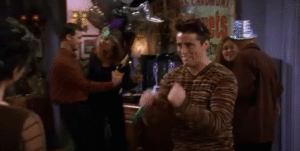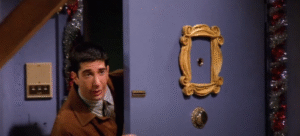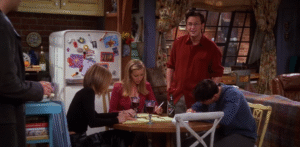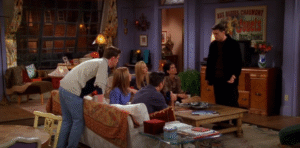Past Continuous
Past Continuous: Como Dar Vida às Suas Histórias e Criar Narrativas Envolventes em Inglês
Você já tentou contar uma história em inglês e sentiu que ela ficou “seca” e sem emoção? Que faltava algo para realmente transportar o ouvinte para o momento que você estava vivendo?
O Past Continuous é o tempo verbal que transforma histórias simples em narrativas cinematográficas. É a diferença entre dizer “I walked” e “I was walking under the rain when suddenly…”
Se você quer aprender a criar histórias que prendem a atenção e soam naturais como as de um nativo, este guia vai revolucionar sua forma de falar sobre o passado!
O Que É o Past Continuous e Por Que Ele É Mágico?
O Past Continuous (também chamado de Past Progressive) é o tempo verbal que usamos para falar sobre:
- Ações que estavam em progresso em um momento específico do passado
- Situações temporárias que duraram por um período no passado
- Ações interrompidas por outros eventos
- Descrições e ambientações de histórias
Pense assim: enquanto o Simple Past conta o que aconteceu, o Past Continuous descreve o que estava acontecendo. É como a diferença entre uma foto e um filme!
Segredo dos nativos: Past Continuous é fundamental para criar suspense, dar contexto e fazer o ouvinte se sentir presente na história.
Como Formar o Past Continuous: A Fórmula Cinematográfica
Estrutura Básica
Sujeito + WAS/WERE + Verbo principal + ING + Complemento
A magia acontece na combinação do passado do verbo “to be” (was/were) com o “-ing” no verbo principal.
Frases Afirmativas
- I was working when you called
- She was studying all night
- They were watching TV at 8 PM
- We were having dinner when it started raining
Frases Negativas
Sujeito + WAS/WERE + NOT + Verbo + ING + Complemento
- I was not (wasn’t) working yesterday
- She was not (wasn’t) studying at that time
- They were not (weren’t) watching TV
- We were not (weren’t) having lunch yet
Frases Interrogativas
WAS/WERE + Sujeito + Verbo + ING + Complemento?
- Was he working late last night?
- Were you studying when I called?
- Was she cooking when you arrived?
- Were they playing soccer at 3 PM?
WAS vs WERE: Nunca Mais Confunda
Use WAS com:
- I was working
- He was sleeping
- She was reading
- It was raining
Use WERE com:
- You were studying (singular ou plural)
- We were talking
- They were playing
Dica infalível: WAS = singular (I, he, she, it) | WERE = plural e “you”
Quando Usar o Past Continuous: Os 5 Casos Que Fazem a Diferença
1. Ações em Progresso no Passado
Para mostrar que algo estava acontecendo em um momento específico:
- At 9 PM last night, I was watching a movie
- What were you doing at 3 o’clock yesterday?
- She was working when the phone rang
Palavras-chave: at (hora específica), when, while, during
2. Ações Interrompidas
Para mostrar uma ação que foi interrompida por outra:
- I was cooking when someone knocked on the door
- She was driving when it started to rain
- They were playing soccer when the ball hit the window
Estrutura: Past Continuous + when + Simple Past
3. Duas Ações Simultâneas
Para mostrar duas coisas acontecendo ao mesmo tempo:
- While I was studying, my brother was playing video games
- She was cooking while he was cleaning the house
- The kids were sleeping while we were watching TV
Estrutura: While + Past Continuous, Past Continuous
4. Descrições e Atmosfera
Para criar o cenário de uma história:
- The sun was shining, birds were singing, and people were walking in the park
- It was raining heavily, and the wind was blowing through the trees
- Everyone was dancing and the music was playing loudly
5. Situações Temporárias Passadas
Para falar sobre situações que eram temporárias no passado:
- I was living with my parents at that time
- She was working as a waitress last summer
- They were studying English when they lived in Canada
Past Continuous vs Simple Past: A Arte da Narrativa
Esta diferença é fundamental para contar histórias envolventes:
Simple Past (eventos concluídos):
- I went to the store (fato simples)
- She called me (ação única)
- They arrived at 6 PM (evento pontual)
Past Continuous (ações em progresso):
- I was going to the store when I met John (ação em progresso)
- She was calling me all afternoon (ação contínua)
- They were arriving as I left (ação em desenvolvimento)
Exemplo narrativo: ❌ I walked. It rained. I got wet. ✅ I was walking home when it started raining. I was getting completely soaked!
Vê a diferença? O segundo exemplo te coloca dentro da história!
Combinações Poderosas: Past Continuous + Simple Past
Padrão 1: Ação Interrompida
Past Continuous + when + Simple Past
- I was sleeping when the alarm went off
- She was driving when she saw the accident
- We were having dinner when you called
Padrão 2: Ações Simultâneas
While + Past Continuous, Simple Past
- While I was cooking, the phone rang
- While she was studying, her friend arrived
- While they were playing, it started raining
Padrão 3: Contexto + Evento
Past Continuous + Simple Past
- The sun was shining when we left home
- Everyone was talking when the teacher entered
- It was snowing when I woke up
Expressões de Tempo Que Indicam Past Continuous
Fique atento a essas “pistas” que sugerem Past Continuous:
Tempo Específico:
- at 8 o’clock, at that time, at that moment
- all day, all night, all morning, all afternoon
- from… to… (from 9 to 5)
Conectores:
- when, while, as, during
Exemplos:
- I was working at 10 PM last night
- She was studying all afternoon
- While he was cooking, I was cleaning
Os 6 Erros Mais Comuns no Past Continuous
Erro #1: Usar “WAS” com Plural
❌ They was playing soccer ✅ They were playing soccer
Erro #2: Esquecer o “-ING”
❌ I was work yesterday ✅ I was working yesterday
Erro #3: Usar com Verbos de Estado
❌ I was knowing the answer ✅ I knew the answer
Erro #4: Confundir “WHEN” e “WHILE”
❌ I was cooking while the phone rang ✅ I was cooking when the phone rang
Erro #5: Usar Past Continuous Para Eventos Pontuais
❌ I was arriving at 6 PM (chegada é pontual) ✅ I arrived at 6 PM
Erro #6: Errar as Regras do “-ING”
❌ I was runing ✅ I was running
Verbos Que Normalmente NÃO Usam Past Continuous
Assim como no Present Continuous, alguns verbos raramente são usados no Past Continuous:
Verbos de Estado Mental:
- know, understand, believe, remember, forget
Verbos de Emoção:
- love, hate, like, prefer, want, need
Verbos dos Sentidos:
- see, hear, smell, taste, feel
Verbos de Posse:
- have (posse), own, belong, possess
Exemplos: ❌ I was knowing him very well ✅ I knew him very well
❌ She was having a car (posse) ✅ She had a car
Exercícios Práticos Para Dominar o Past Continuous
Complete com Past Continuous ou Simple Past:
- I _____ (read) when you _____ (call) me
- While she _____ (cook), the kids _____ (play) outside
- What _____ you _____ (do) at 9 PM yesterday?
- They _____ (watch) TV when the lights _____ (go) out
- It _____ (rain) all day yesterday
Respostas: 1. was reading/called, 2. was cooking/were playing, 3. were/doing, 4. were watching/went, 5. was raining
Transforme usando Past Continuous:
- I worked all morning → I _____ all morning
- She studied when I arrived → She _____ when I arrived
- They played soccer at 3 PM → They _____ soccer at 3 PM
- We watched TV last night → We _____ TV at 8 PM last night
- He cooked dinner → He _____ dinner when you called
Respostas: 1. was working, 2. was studying, 3. were playing, 4. were watching, 5. was cooking
Como o Past Continuous Transforma Suas Histórias
Past Continuous não é apenas gramática – é storytelling. Quando você domina este tempo verbal:
- Suas histórias ganham profundidade e emoção
- Você consegue criar suspense e atmosfera
- Os ouvintes se sentem presentes nos momentos que você viveu
- Suas conversas ficam mais interessantes e envolventes
Compare: ❌ “I went to the park. John was there. We talked.” ✅ “I was walking to the park when I saw John. He was sitting under a tree, and we ended up talking for hours.”
Qual versão te prende mais? A segunda, óbvio!
Por Que Brasileiros Têm Dificuldade Com Past Continuous?
O principal desafio é que em português, usamos estruturas diferentes:
Português: “Eu estava trabalhando quando você ligou” Inglês: “I was working when you called“
Parece similar, mas a combinação com Simple Past é mais complexa em inglês. Além disso, o uso de “was/were” pode confundir com “ser/estar”.
A chave está na prática contextualizada – aprender através de histórias reais, não apenas exercícios isolados.
Eleve Suas Conversas Para o Próximo Nível
Past Continuous pode parecer um detalhe, mas é o que separa uma comunicação básica de uma comunicação sofisticada.
Você já percebeu como suas histórias em inglês soam “sem vida” comparadas às suas histórias em português?
O problema geralmente é a falta de domínio dos tempos que criam atmosfera e contexto.
Nas minhas aulas, você vai:
- Praticar Past Continuous através de storytelling real
- Aprender a combinar tempos verbais para criar narrativas envolventes
- Desenvolver automatismo no uso de “was/were” + “-ing”
- Transformar histórias simples em narrativas que prendem a atenção
Construindo Narrativas Completas
Past Continuous trabalha em harmonia com outros tempos para criar histórias ricas:
- Simple Past: eventos principais
- Past Continuous: contexto e atmosfera
- Past Perfect: eventos anteriores
- Present Perfect: conexão com o presente
Quando você domina essas combinações, suas histórias ficam no nível de um nativo.
A diferença entre um estudante intermediário e avançado está na capacidade de criar narrativas complexas e envolventes.
Conclusão: Suas Histórias Merecem Brilhar
O Past Continuous é sua ferramenta para transformar fatos em experiências, eventos em aventuras, e conversas em momentos memoráveis.
Mas lembre-se: conhecer a teoria é só o começo. A fluência vem quando você consegue usar Past Continuous automaticamente para criar atmosfera e contexto.
Cada história que você não conta com toda sua riqueza é uma oportunidade perdida de conexão.
Se você quer dominar a arte de contar histórias em inglês e fazer suas conversas brilharem com naturalidade, minhas aulas oferecem o caminho mais eficiente para essa transformação.
Pronto para dar vida às suas histórias? Entre em contato e descubra como posso ajudar você a dominar o Past Continuous e se tornar um contador de histórias irresistível em inglês. Suas conversas nunca mais serão as mesmas!








Publicar comentário